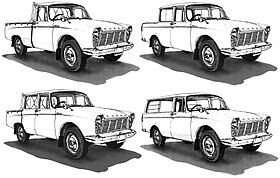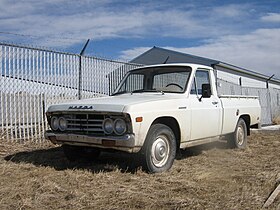Mazda B-Series
| Mazda B-Series | |
|---|---|
 |
|
| Overview | |
| Manufacturer | Mazda |
| Production | 1961–2006 |
| Chronology | |
| Successor |
Mazda BT-50 Ford Ranger |
| First generation | |
|---|---|

The first B1500 model: top left is the original truck, to the right the "Pickup", bottom left is the double-cab truck and on the bottom right is the "Light Van".
|
|
| Overview | |
| Production | 1961–1965 |
| Assembly | Japan: Hiroshima |
| Body and chassis | |
| Body style | 2-door pickup truck 2-door double-cab pickup truck 2-door double-cab coupé utility 2-door van |
| Layout | Front-engine, rear-wheel-drive |
| Powertrain | |
| Engine | 1.5 L UA OHV I4 |
| Dimensions | |
| Wheelbase | 2,495 mm (98.2 in) (BUA) 2,590 mm (102.0 in) (BUB61) |
| Length | 4,150 mm (163.4 in) (BUA61) 4,245 mm (167.1 in) (BUB61) |
| Second generation | |
|---|---|

Mazda B1800 (US)
|
|
| Overview | |
| Also called | Mazda Proceed Mazda B1500/1600/1800 Mazda Rotary Pickup Ford Courier |
| Production | 1965–1977 |
| Assembly | Japan: Hiroshima New Zealand |
| Body and chassis | |
| Body style | 2-door truck |
| Layout | Front-engine, rear-wheel-drive |
| Powertrain | |
| Engine | 1.3 L TC I4 (BTA67) 1.5 L UA OHV I4 (BUD61) 1.6 L NA I4 (BNA61) 1.8 L VB I4 1.3 L 13B |
| Dimensions | |
| Wheelbase | 2650 mm |
| Length | 4370 mm |
| Third generation | |
|---|---|
 |
|
| Overview | |
| Also called | Ford Courier Mazda Proceed |
| Production | April 1977–1985 |
| Assembly | Japan: Hiroshima, Japan Colombia: Bogotá Iran: Tehran (Bahman Group) |
| Body and chassis | |
| Body style | 2-door pickup, standard and long bed |
| Layout | Front-engine, rear-wheel-drive |
| Powertrain | |
| Engine | 1.6 L NA I4 1.8 L VC I4 1.8 L VB I4 (US) 2.0 L MA I4 2.0 L FE I4 2.2 L S2 diesel I4 |
| Transmission | 4/5-speed manual 3-speed automatic |
| Dimensions | |
| Wheelbase | 2,715 mm (106.9 in) (SWB) 2,865 mm (112.8 in) (LWB) |
| Length | 4,445 mm (175.0 in) (SWB) 4,740 mm (186.6 in) (LWB) |
| Fourth generation | |
|---|---|
 |
|
| Overview | |
| Also called | Ford Courier (pickup) Ford Raider (wagon) Ford Marathon Mazda Bravo Mazda Fighter Mazda Magnum Mazda Proceed |
| Production | 1985–1998 |
| Assembly | Japan: Hiroshima Colombia: Bogotá South Africa: Pretoria Zimbabwe: Willowvale (WMMI) |
| Body and chassis | |
| Body style | 2-door pickup 4-door pickup 4-door wagon |
| Layout |
Front-engine, rear-wheel-drive Front-engine, four-wheel-drive |
| Related | Mazda Proceed Marvie |
| Powertrain | |
| Engine | 2.0 L FE I4 2.2 L F2 I4 2.6 L G54B I4 (Mitsubishi) 2.6 L G6 I4 2.2 L R2 diesel I4 2.5 L WL-T td I4 |
| Transmission | 5-speed manual 4-speed automatic |
| Dimensions | |
| Wheelbase | 108.7 in (2,761 mm) 117.5 in (2,984 mm) 109.3 in (2,776 mm) 118.1 in (3,000 mm) |
| Length | 182.7 in (4,641 mm) 198.8 in (5,050 mm) |
| Width | 65.7 in (1,669 mm) 67.1 in (1,704 mm) |
| Height | 61.8 in (1,570 mm) 61.6 in (1,565 mm) 66.1 in (1,679 mm) 65.9 in (1,674 mm) |
| Fifth generation | |
|---|---|
 |
|
| Overview | |
| Also called | Mazda Bravo Mazda Fighter Mazda Proceed Ford Courier (pickup) Ford Everest (wagon) Ford Ranger (pickup) |
| Production | 1998–2006 |
| Assembly | Japan: Hiroshima Colombia: Bogotá Philippines: Santa Rosa, Laguna South Africa: Pretoria Taiwan: Zhongli Thailand: Rayong (AAT) Vietnam: Hai Duong (Ford Vietnam) Zimbabwe: Willowvale (WMMI) |
| Body and chassis | |
| Class | Compact pickup truck Mid-size SUV (Ford Everest) |
| Body style | 2-door pickup 2-door pickup (extended cab) 4-door "Freestyle" pickup (suicide rear doors) 4-door pickup 5-door wagon (Ford Everest) |
| Layout |
Front-engine, rear-wheel-drive Front-engine, four-wheel-drive |
| Powertrain | |
| Engine | 2.2 L F2 I4 2.6 L G6E I4 2.5 L WL diesel I4 2.5 L WL-T TD I4 |
The Mazda B-Series is a pickup truck that was first manufactured in 1961 by Mazda. Since the launch of the B-Series, Mazda has used the engine displacement to determine each model's name; the B1500 had a 1.5 L engine and the B2600 had a 2.6 L engine. In Japan, the name Mazda Proceed was used for the compact pickup. Other names used for this line include Mazda Bravo (Australia), Mazda Bounty (New Zealand), Mazda Magnum/Thunder/Fighter (Thailand), and Mazda Drifter (South Africa).
Mazda's partnership with Ford resulted in both companies selling this vehicle under different names; Ford called its version the Ford Courier, and later the Ford Ranger. The Mazda B-Series and Ford Ranger models sold in North America were developed by Ford, whereas models sold elsewhere under the same badge were engineered by Mazda.
The Mazda B-Series pickup truck was introduced in Japan in August 1961 as the B1500 (BUA61). This model was the only Japanese market model to be badged under the B-Series naming scheme, i.e. B1500. The BUD61 (second generation) that followed was the first model of the long-running "Proceed" series sold in Japan. It had a 1,484 cc OHV water-cooled engine with wet sleeve cylinders which produced 44 kW (59 hp; 60 PS), and a one-ton payload. This model also had a torsion bar front/leaf spring rear suspension, which was advanced for its time, giving it a relatively smooth ride. The B1500 was remodeled between late 1962 and September 1963; it received a new chassis code, BUB61. The BUB61 was more spacious; its cabin was extended by 80 mm (3.1 in) and it had a stretched body and wheelbase. The BUB61 had a new, upside-down, trapezoidal grille instead of the earlier full-width unit, with thirteen bars rather than nine, turn signals on the fenders, and more chrome trim—including a decor strip on the side.
In addition to the standard two-door "styleside" pickup truck body, a double-cab truck and a similar double-cab version called the "pickup", which had a fully integrated coupé utility body rather than the separate bed of the truck versions were produced. The "pickup" model was based on the light van; it had a two-door van model with a fold-down tailgate and an electrically powered window, which was rare in the Japanese market at the time. The light van (BUAVD) was introduced in September 1962, and two double-cab models followed shortly after. These three models were built on the shorter wheelbase chassis; when the longer chassis was introduced it was not deemed worthwhile to create new bodywork. These models were produced for only a few months. The B1500 was sleeker and considerably more powerful than its competitors in the Japanese market, but it was considerably more expensive and it failed to sell in the expected quantities.
...
Wikipedia
